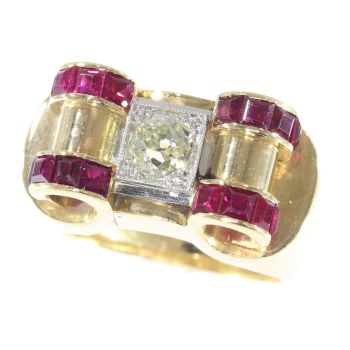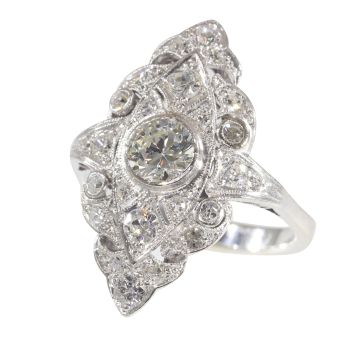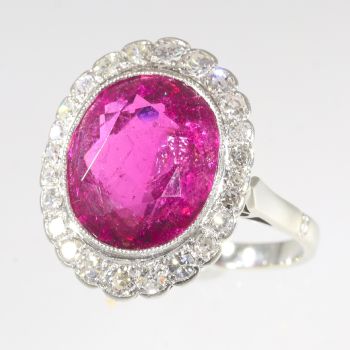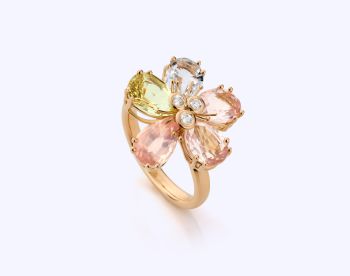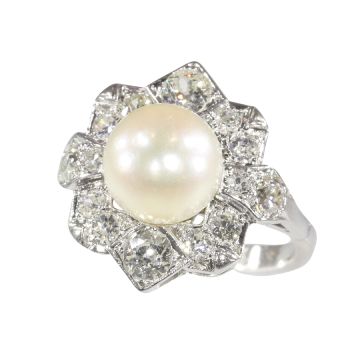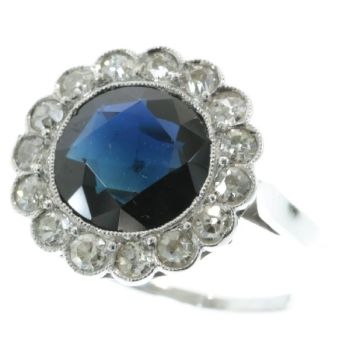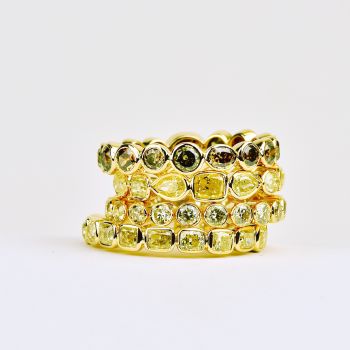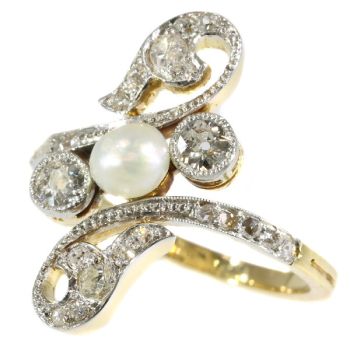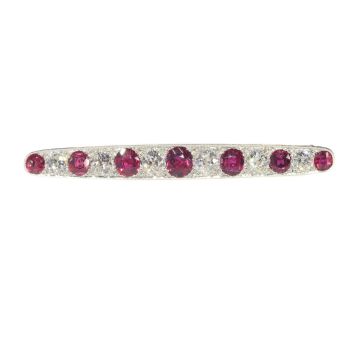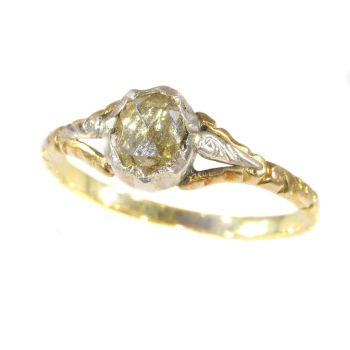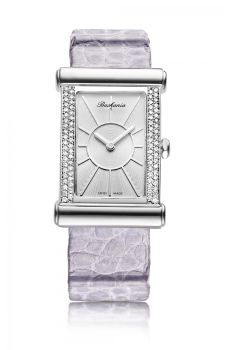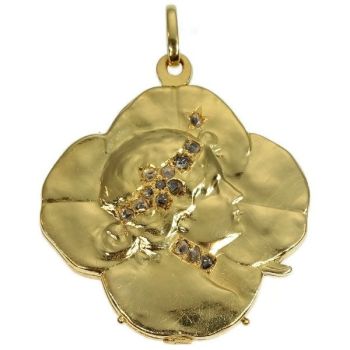Wièse's 4.86ct Diamond Ring, a Neo-Renaissance Legacy 1900
Wièse
Adin Fine Antique Jewellery
- Über Kunstwerk
This Late-Victorian Neo-Renaissance ring by Jules Wièse is a museum-quality marvel in Haute Joaillerie. Crafted in France from 18K yellow gold and platinum, the ring incorporates two putti, symbolic of love and innocence, adding layers of historical andemotional meaning. At its core lies a 4.86-carat old European cut diamond. Wièse's craftsmanship is renowned, even cited in multiple academic books on 19th-century jewellery. Authenticated by Wièse's signature and French hallmarks, this ring is apinnacle of craftsmanship and a timeless heirloom, captivating collectors and destined for future generations to be amazed by its uniqueness.
Antique jewelry object group
ring
Condition
excellent condition
more info on our condition scale
Country of origin
France
Style
Victorian / Neo Renaissance
more info on styles
Style specifics
Neo-Renaissance jewellery refers to pieces inspired by the art and culture of the Renaissance period, which spanned from the 14th to the 17th centuries. Created primarily in the late 19th and early 20thcenturies, Neo-Renaissance jewellery aimed to replicate the grandeur and intricacy of its historical predecessor. Artisans of this movement often utilised traditional materials like gold, enamels, and precious gemstones, meticulously crafting them into elaborate designs that featured a variety of motifs, such as mythological scenes, putti, and intricate floral patterns.
The Neo-Renaissance movement was largely a European phenomenon, with France being a key player in its development. Renowned jewellers like Jules Wièse elevated the craft to new heights, creating pieces that were not mere replicas but original works of art that incorporated Renaissance elements. These jewellery pieces were considered the epitome of luxury and sophistication, valued not just for their materials but also for their exquisite craftsmanship and detailed ornamentation. They are now highly sought after by collectors and can be seen as timeless heirlooms, capable of captivating future generations with their unique blend of history and artistry.
Period
ca. 1900
Events & facts of this era, poetry of this era, fashion of this era.
Source of inspiration
Renaissance
Theme
two putti, one male, one female
The use of two putti—one male, one female—could symbolise romantic or divine love, a union of opposites, or the harmony and balance achieved through such a union.
Material
18K yellow gold and platinum (touchstone tested)
more info on precious metals
Extra information
Louis Wièse was the son of famed 19th-century French jeweller Jules Wièse and continued his father's legacy of exceptional craftsmanship. Like his father, Louis excelled in creating intricate designs inspired by historical and religious themes. His work, often executed in gold and featuring detailed ornamentation, represents some of the finest examples of 19th-century French jewellery. Louis Wièse contributed to maintaining thefamily's esteemed reputation, with pieces today equally coveted by collectors and displayed in significant museums globally.
Diamonds
One old European cut diamond with an estimated weight of ± 4.86ct colour and clarity L, si1 (see pictures for HRD certificat)
Birthstones
Diamond is the birthstone (or month stone) for April.
more info on birthstones
Brand
Wièse
Signature
Wièse (see pictures)
Hallmarks
Wièse mastermark and the French control mark for 18K gold representing an eagle's head that was in use in France from about 1838. (see pictures for close ups)
more info on hallmarks
Dimensions
width top of ring 1,37 cm (0,54 inch)
see picture with a ruler in millimeters and inches
Weight
10,70 gram (6,88 dwt)
Ring size 52
more info on ring sizes
Adin Reference Nº
20027-0039
Copyright photography
Adin, fine antique jewellery
Sources
- Le Bijouterie Francaise au XIX Siècle par Henri Vever (volume 2 page 213 for similar ring)
- Henri Vever French Jewelry of the Nineteenth Century (page 1013)
- Jules Wièse und sien Atelier (similar rings in the book)
- Pariser Schmuck (page 49 for a ring in the same idea & page 44 for the Wièse mark)
- Dictionnaire des joailliers, bijoutiers et orfèvres en France de 1850 à nos jours By: L'École des Art Joailliers avec le soutien de Van Cleef & Arpels.
Additional information
our latest acquisitions
jewelry glossary
wall of fame
visit us in Antwerp
subscribe to our mailinglist
- Über Künstler
In der zweiten Hälfte des 19. Jahrhunderts begannen Goldschmiede, sich zunehmend von vergangenen Epochen inspirieren zu lassen, indem sie antike und mittelalterliche Artefakte verwendeten und gleichzeitig längst vergessene Techniken wiederbelebten. In Frankreich erfreuten sich die Stile Neugotik und Renaissance besonders großer Beliebtheit und verschmolzen zu dem, was als „Style Cathédrale“ bekannt wurde.
Einer der Koryphäen dieser Designbewegung war Jules Wièse (1818-1890). Er reiste 1839 von Berlin nach Paris und begann seine Karriere im renommierten Atelier des Juweliers und Silberschmieds Froment-Meurice. Dieser unternehmungslustige Handwerker stieg rasch auf und übernahm 1844 die Position des Werkstattleiters. Im folgenden Jahr wagte er den mutigen Schritt, eine eigene Werkstatt in der Rue Jean-Pain-Mollet 7 zu eröffnen. Wièse schuf sich bald eine eigene Nische und spezialisierte sich auf die Herstellung von aufwendig ziseliertem Schmuck und Kunstgegenständen aus Silber und Gold.
Seine herausragende Handwerkskunst blieb nicht unbemerkt. Wièse erhielt Auszeichnungen auf der Exposition Industrielle von 1849 und 1855 wurde ihm auf der Exposition Universelle eine erstklassige Medaille verliehen. Ein Kritiker kommentierte seine Arbeit auf der Ausstellung von 1855 wie folgt: „Die Bedeutung seiner Werke und seine gewagten Experimente offenbaren eine Wertschätzung für Kunst und Schönheit, die selbst bei den unscheinbarsten Werken die Anerkennung der Jury verdient.“ Wièses bemerkenswertes Können und seine Originalität erlangten bald internationale Anerkennung, als er auf der Great London Exhibition 1862 mit einer Auszeichnungsmedaille geehrt wurde.
Wièses Werk war eine harmonische Verschmelzung mittelalterlicher Motive und traditioneller handwerklicher Methoden. Er ließ sich von der Artuslegende, Rittermärchen, gotischer Architektur und verschiedenen Kunstformen der Zeit inspirieren. Seine Schmuckstücke waren oft mit einer sorgfältig aufgetragenen Quecksilberoxidbeschichtung versehen, die ihnen ein antikes, geschwärztes Aussehen verlieh. Bei Goldgegenständen wurde manchmal Juwelierrouge verwendet, um ihnen das Aussehen frisch ausgegrabener Schätze zu verleihen.
Im Jahr 1880 ging Jules Wièse in den Ruhestand und übergab die Leitung der Werkstatt an seinen Sohn Louis. Von Vever als „ein außergewöhnlich bescheidener und wirklich talentierter Künstler“ beschrieben, produzierte Louis bis zur Schließung der Firma im Jahr 1923 weiterhin Schmuck im Revivalist-Stil.
Der Schmuck von Wièse, bekannt für seine charmante Exzentrizität und exquisite Handwerkskunst, ist bei Sammlern und Kennern nach wie vor sehr begehrt und gefragt. Beispiele seiner Arbeit finden sich in angesehenen Institutionen wie dem British Museum, dem Victoria & Albert Museum und dem Musée des Arts Décoratifs in Paris.
Sind Sie daran interessiert, dieses Kunstwerk zu kaufen?
Artwork details
Related artworks
- 1 - 4 / 24
- 1 - 4 / 24
- 1 - 4 / 24
- 1 - 4 / 12




































